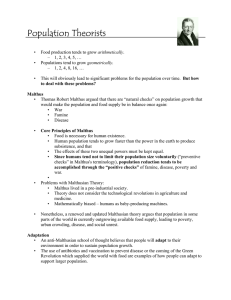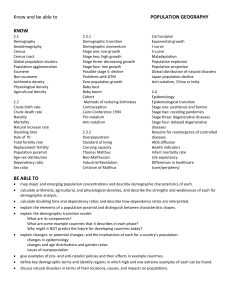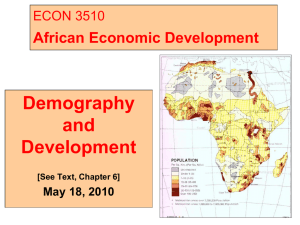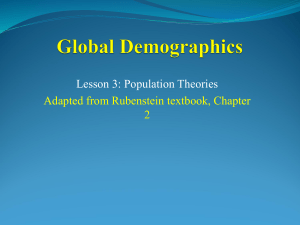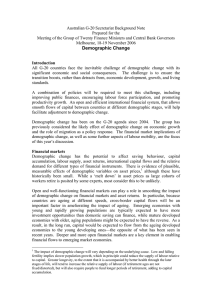October 17 and 22
advertisement
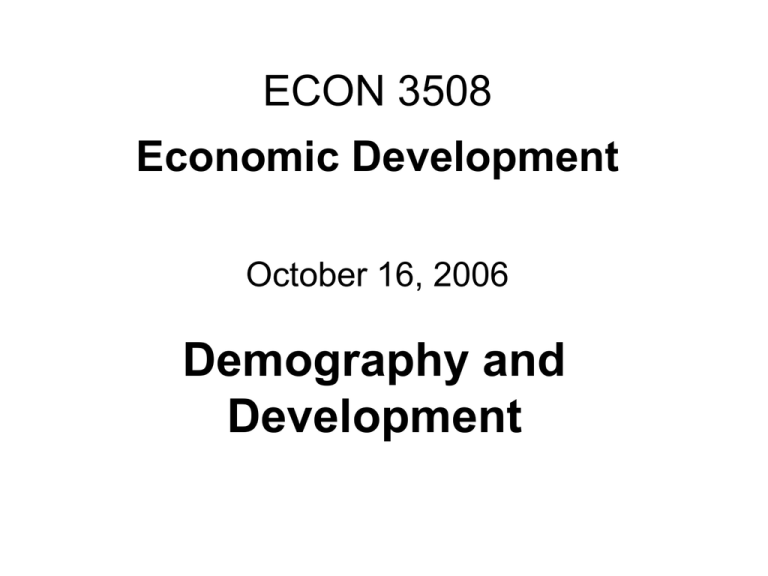
ECON 3508 Economic Development October 16, 2006 Demography and Development World Population I. Thomas R. Malthus & Population Growth 1. Background on Parson Malthus [1766-1834] 2. Theory of Population Growth: - people had an uncontrollable urge to procreate! [This would not diminish as civilization progressed.] - population growth would continue at a rapid pace (“geometrically”) - Agriculture was subject to limited land and diminishing returns. (“arithmetic”) - population would expand to the point where the “positive checks” would operate. Famine, Disease and War. Result: incomes would fall to the starvation level. Life would be “nasty, brutish and short” for the vast majority of human beings. Is this or was this in fact the case? An Economic History of the World! (courtesy of G. Clark, A Farewell to Alms) Real Output per Worker in England, 1260-1960. (G.Clark) Real Wage Levels, Europe, (G. Clark) Was there any escape from this fate? 3. Malthus’ Recommendation: Establish “Preventative Checks” on population: - “Moral Restraint,” - Delay of marriage How probable was this? 4. Was Malthus’ Vision Correct? In general “No,”though some parts of the world are caught in a “Malthusian Population Trap.” e.g. Rwanda? Haiti. Why or Why Not? Malthus’ predictions: in large part unfulfilled: 1. Technology of contraception was unforeseen; 2. Family Planning; 3. Technological change has postponed the impacts of serious diminishing returns; agricultural output has in fact grown more rapidly than population. Why? 4. Has the “urge to procreate” declined? 5. Social and sociological impacts of “Modernization” and Urbanization on birth rates was unforeseen: - Higher female labour force participation; - Higher status for women: increases education and reduces child-bearing - Higher costs of raising children in modern urban areas vis-à-vis agriculture and rural areas - Cultural factors: more Television etc. etc. - Less need for children as family labour and old age security; Graphical Version of Malthusian Trap (Class and text, pp. 277-281) II. Theory of the Demographic Transition (See Chart below, on transparency and in Text) Stage 1:High Birth Rate and Death rate: Population stability Stage 2: Falling death Rate; Continuing High Birth Rate: Population increasing faster and faster; Stage 3: Death Rate DDecline Intensifies; Birth Rate Decline accelerates; Population Growth continues but decelerates Stage 4: Low Death Rate and Low Birth Date: Population Stability To which I would add Stage 5: The Current Reality? Death Rates Continue at a low level; Birth Rates fall further; Population Size Declines www.ldeo.columbia.edu/edu/dees/V1003/imagres/demographic .transition2 Stage V, a la Wikipedia! Explaining the Demographic Transition Factors Affecting Death Rates: Factors Affecting Birth Rates: Usefulness of Approach III. The Microeconomic Theory of Fertility Application of basic microeconomic theory to the child-bearing decision. Assumption: children are at least in part an good like others, providing “consumption” benefits to the parents and serving also as an investment good (providing and) Possible economic benefits of additional children: Old-age security Expected income from child labour Costs of additional children: Opportunity cost of Mothers’ time Opportunity and actual costs of educating, & looking after children How to reduce fertility rates? IV. A Note on Demographic Structures: See: http://www.census.gov/ipc/www/idbpyr.html Developing Countries: e.g. India Kenya China Chile …. High Income Countries: e.g. Russia Japan Canada • Explain the “Demographic Window of Opportunity” with the Chinese Case. • Note the prospective “Aging Population” phenomenon and reductions in the relative size of the labour force V. Implications of Rapid Population Growth for Economic Development 1. Impact on Income per Capita: When population is growing rapidly, economic growth must grow exceed Population Growth Rates. 2. Effects on Savings Rapid population growth tends to increase family and national consumption 3. Investment Rapid population growth requires that large amounts of resources must be devoted to investments, which merely accommodate or keep up with Population. 4. Dependency ratios: Rapid population growth leads to “bottom heavy” population pyramids, which means the population of a country of working age is relatively smaller. 5. Effects on Employment and Unemployment: Ever-growing cohorts of young people are entering the job market. 6. Impacts on Income Distribution: Because family size is highest among the poor, rapid population growth affects income distribution negatively. start off in life or to give to them as inheritances. 7. Environmental Impacts Population growth in many places results in poor rural people being pushed into ever more marginal and environmentally-inappropriate farm lands. 8. Rapid Urbanization VI. Population Policies Should governments pursue active population control policies or should they wait for the “Demographic Transition” to occur automatically? This has been controversial, for various reasons Types of Programs: 1. Internal Migration? A few countries have tried to relieve population pressures in some areas by migration to other under-populated areas (Amazonia in Brazil; the outer islands in Indonesia.) Limited potential plus other problems. 2. International Migration? The annual population increase in Asia Africa and Latin America is too large to be relieved significantly via international migration. However, for some small countries such as the smaller Englishspeaking Caribbean countries this has been possible’ 3. Constructing a policy environment promoting greater desire for smaller families Governments can structure a variety of programs and policies which can change the environment in which families decide to have children, in ways that will induce them to reduce family size. Of especial importance are – – – – policies enhancing the status of women, promoting education in general and especially for girls, promoting breast-feeding, reducing child labour, promoting higher labour force participation rates for women, – improving social security and pensions (so fewer children are necessary to look after their aged parents.) 4. Specific Family Planning Programs. • If families want smaller families due to the types of factors listed above and discussed previously in the course. Making family planning facilities available can have an important impact. • If families want large families in any case (for family labour purposes, for old-age security) they may not be interested in family planning facilities even if they are available.
